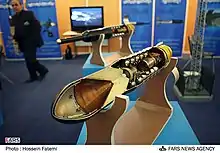Saegheh
The Saegheh ("Lightning" or "Thunder" in Persian) (also spelled Saegre, Saeghe, Saeqeh, etc.) refers to at least six completely separate Iranian weapons systems: a RPG warhead, an anti-tank guided missile family, a surface-to-surface rocket, a target drone family, an air-to-air missile and a claimed stealth Unmanned aerial vehicle.

The first system, the Saeghe 1, is an Iranian reverse-engineered clone of the American M47 Dragon wire-guided SACLOS ATGM, introduced in 2001.[1][2] It seems to have entered production in 2002.[3] Iran later introduced the Saeghe 2, a more advanced variant with a tandem-warhead to defeat explosive reactive armor,[4] and the Saeghe-4, with a thermobaric warhead.[5] The Saeghe-1 weights 6.1 kilograms (13 lb) and can penetrate armor up to 500 millimetres (20 in). The 7.4-kilogram (16 lb) Saeghe 2 missile has a tandem warhead and can penetrate up to 760 millimetres (30 in) of armor.[4] The Saeghe 1 and Saeghe 2 ATGMs have a range of 50 to 1,000 metres (160 to 3,280 ft).[4]
Despite being essentially obsolete, Saegheh anti-tank guided missiles have been exported to Syria, Hezbollah,[6] and Shia militias in Iraq.[7] The Saeghe 1 and Saeghe 2 were in production and service as of 2011, though they were not widely deployed.[8] The Saeghe ATGM is extremely hard to aim and in Iranian service it appears to be limited to IRGC and rapid response forces.[9]
In 2006, Iran tested a completely unrelated short-range surface-to-surface missile that is also named "Saegheh." It has a range of 80 to 250 kilometres (50 to 155 mi).
Under the Saegheh name, Iran has also built a variant warhead for RPG-7 style rocket launchers. Iran also uses the Saeghe name for a target drone[11] (which comes in two variants: Saeghe 1 and Saeghe 2[12]) and an air-to-air missile.[13]
The semi-official Tasnim news agency of Iran reported in September 2016 that an unmanned aerial vehicle (UAV, drone) named Saegheh similar to the US RQ-170 Sentinel spy drone had been built. It was said to be able to carry four precision-guided bombs; range was not stated. An RQ-170 had been captured by Iran in 2011.[14]
See also
- Current Equipment of the Iranian Army
- Iran's missile forces
- Iranian military industry
- Military of Iran
References
- People's Daily Online Iran Successfully Test-fires Anti-Armor Missile
- Pavland News Iran test-fires anti-armor missile - July 31, 2001
- https://web.archive.org/web/20030508113258/http://www.menewsline.com/stories/2002/december/12_03_4.html
- http://www.mashreghnews.ir/fa/news/134666
- https://imp-navigator.livejournal.com/690111.html
- https://medium.com/@badly_xeroxed/common-atgms-in-the-syrian-civil-war-6395ea4305ec
- https://twitter.com/oryxspioenkop/status/733346617269583872
- Galen Wright, Iranian Military Capability 2011 - Ground Forces - March 15th 2011
- Lyamin, Yuri (5 October 2012). "Легкое противотанковое вооружение Ирана. Часть 1" (in Russian).
- https://web.archive.org/web/20071013165941/http://www.nti.org/e_research/profiles/Iran/Missile/1788_1815.html
- http://www.mindexcenter.ir/product/saeghe-2-aerial-target-system
- https://www.globalsecurity.org/military/world/iran/saeqeh.htm
- "Iran builds attack drone similar to captured US model, local media say". The Guardian. 2 October 2016. Retrieved 2 October 2016.
External links
- China View Video and info